Mad Hedge Technology Letter
February 13, 2018
Fiat Lux
Featured Trade:
(CHASING NVIDIA),
(NVDA)

Mad Hedge Technology Letter
February 13, 2018
Fiat Lux
Featured Trade:
(CHASING NVIDIA),
(NVDA)

Long term readers of this letter know too well that after tripling from my initial forecast of $68 a share, that the shares of NVIDIA would double again.
After listening to their Q4 earnings call, I now have to confess that I was wrong my in assessment.
It now looks like NVIDIA shares will triple off of the recent $180 low.
From what I heard, the call was nothing less than amazing.
When considering companies limited by imagination, the last one I would anoint is Nvidia (NVDA).
I have been pounding the table for years, pleading with readers to drop everything and get into this battering ram of a stock.
If you didn't, well, you aren't buying at the bottom, but the future potential for Nvidia cannot be understated. Nvidia stands atop a parapet, scoffing at its enemies who simply cannot compare.
Its superior strategic position in GPU (graphics processing units) chips has forced the tech community to adopt its platform as the building blocks of A.I., machine learning, data center, and autonomous car technology.
In fact, Nvidia has only scratched the surface of its potential. The sustained growth story is not only intact but accelerating at a rapid clip.
The first chapter of Nvdia's rise to glory was on the back of e-gaming and the subsequent demand for their GPUs. The most talented gamers require the superior GPU's for faster processing speeds and crisper visuals that aid playing levels.
Casual gamers seem to upgrade their GPU's as well, since many of these participants cut their teeth jostling with their online counterparts 10 hours/day.
The main beneficiary of the GPU gaming upgrade boom is the model NVIDIA Pascal. This chip has the world's most advanced gaming GPU architecture, delivering truly game-changing performance, innovative technologies, and immersive, next-gen virtual reality.
Offering scintillating gameplay, it's a rung up in the gaming world. Additionally, the companies that manufacture gaming consoles are part and parcel in this GPU game of thrones. Sales of the Nintendo Switch provided a boost to Nvidia's Tegra processor revenue, tallying up to $450 million, up 75% YOY.
On a stand-alone basis, Nvidia is knocking the ball out of the park in terms of a pure gaming stock, but it is so much more than that. Nvidia IS the future. This was all apparent in last week's earnings call, which I shall outline below.
Data Centers
Revenue of $606 million was up a staggering 105% YOY, and up 20% QOQ. This over performance reflected strong adoption of Tesla V100 GPUs based on the Volta architecture, which began shipping in Q2 and continued to solidify in Q3 and Q4 2017.
V100's are present in every mainstream computer made by every major company, and have been chosen by every major cloud provider to deliver A.I. and high-performance computing.
Cloud customers adopting the V100 include Alibaba, Amazon Web Services, Baidu, Google, IBM, Microsoft Azure, Oracle and Samsung.
Nvidia perpetuates leadership in the AI training markets where their GPU's remain the platform of choice for training and machine learning networks. Any well-known company looking to A.I. functionality in the data center space relies on Nvidia to carry the load.
Nvidia posted a growing traction in the A.I. inference market where NVIDIA's platform can improve performance and efficiency by many degrees of magnitude over CPU's.
"Inference?" is the technology that puts sophisticated neural networks, trained on powerful GPUs, into use, solving problems for everyday users. Nvidia considers A.I. inference as a cogent new opportunity for the data center GPUs.
Nvidia is also gaining influence for A.I. in a growing number of vertical industries such as transportation, energy, manufacturing, smart cities, and healthcare.
The most poignant data center technology innovation was Tensor Core, a unique feature of the new Volta GPU Architecture. This technology alone can successfully complete rapid deep learning, and it officially increases the throughput of deep learning by 800%.
Autonomous Driving
Nvidia flaunted their leading position in autonomous vehicles with several salient landmarks and new partnerships. A.I. self-driving cars are trending towards moving from deployment to production.
Jensen Huang, the genius who is the CEO of Nvidia, announced that DRIVE Xavier, the world's first autonomous machine processor, will be available for the first time this quarter with more than 9 billion transistors.
DRIVE Xavier is the most complicated system Nvidia has ever delivered to customers. Recently trotted out, NVIDIA Drive is the world's first functional A.I. self-driving platform, enabling automakers to create autonomous vehicles they can operate safely.
This is a necessary component to prove its technology is ready for mass market. Several dynamic collaborations have begun with Uber, which has integrated A.I. video technology for its fleet of self-driving cars and freight trucks.
Production vehicles utilizing NVIDIA drive technology include vehicles from Chariot. Chariot is a privately-owned commuter shuttle service that is currently in the process of being acquired by Ford.
The company's mobile-phone application allows passengers to hop on a shuttle between home and work during commuting hours. Chariot currently operates in several neighborhoods in Silicon Valley and plans to swiftly expand to other locations around the United States. The Chariot fleet expects to be fully functional and possess automation capability by 2020.
Over 320 firms are now using the NVIDIA Drive platform, up 50% YOY, including almost every relevant car maker, truck maker, robo-taxi company, mapping company, car parts manufacturer and start-up in the autonomous vehicle ecosphere.
Nvidia has strategically placed itself on the front line hoping to expedite the roll out of this technology in the form of a massive fleet, servicing the individual. The obsolescence of human drivers is closer than you think.
Autonomous driving is the most significant paradigm shift in the history of the automotive industry. In total, transportation is a $10 trillion industry and I am not exaggerating when I say this will completely reshape our daily lives.
Vehicles will be fully or partly autonomous, depending on the entity. The potential of this market is massive.
The imminent monetization process will commence in 2019 and 2020, but if I had to bet money, I would say widespread profiteering will not occur until 2022.
The first goal is to train a network of autonomous driving capabilities, and this will be aided by creating a platform named NVIDIA GTX that grants everybody the chance to train a neural network promptly.
The inherent development of the A.I. requires top end GPU's, and Nvidia harvests a good portion of the spoils.
The second phase would be development platforms for the cars themselves and all these tasks will be executed by Nvidia Xavier SoC.
A system-on-a-chip (SoC) is a microchip with all the necessary electronic circuits and parts for a given system, such as a smartphone or wearable computer, on a single integrated circuit (IC).
Xavier is the most complex SoC that humankind has ever invented. All previous NVIDIA DRIVE software development carries over and runs with this consolidated architecture.
The prices for Nvidia GPU's split because the mix of solutions are unique. Autonomous vehicles that still have physical drivers will fetch a price between $500 to $1,000 per GPU.
Autonomous vehicles without drivers will command a price of $2,000-$3,000 per GPU. In general, the industry will see large-scale deployment starting FY 2018.
Practically every car produced in 2022 and beyond will have autonomous driving capabilities, requiring copious amounts of Nvidia GPU chips.
Huang repeatedly complains that Nvidia cannot keep up with the insane demand of these new technologies. There will be a persistent GPU shortage for the foreseeable future.
What does the future of AI behold aside from the imminent sensations of autonomous vehicles?
At a basic level, A.I. can be used for many things, such as improving images. For instance, you could reconstruct a photograph using A.I.. You could correct blemishes or parts of the image that haven't been rendered yet. A.I. would be used to fill in the holes, predict the future, and render results.
Let's take it one step further.
Extrapolating this concept to broader designs of everything, say cars, A.I. will be used to generate their designs in the future.
You could draw the first few preliminary scribbles of a car design and based on the inventory, safety, physics, consumer demands and other crucial inputs, the A.I. technology would complete the remaining 90% of the design.
This new type of design technology is called generative design and will revolutionize the way people do business.
My prognosis in the future of developing software is a world where computers can write their own software and this software will be so dense and complex that no human can replicate the task.
Essentially, we will be coaching up data to teach software how to write it's own software through machine learning. And imagine the new business applications introduced by this potential software!
Did I mention that Nvidia is also returning $1.25 billion to shareholders in FY 2019 and receiving another tailwind of high single digit growth in bitcoin mining?
Of course, all of that pales in comparison to the potential big picture profits Nvidia could realize. Jensen Huang has told investors that he expects A.I. to be a $10 billion/year business and autonomous technology to be a $40 billion/year business.
Remember that their most stable segment now is e-gaming GPUs which are only a paltry $3 billion/year in total revenue.
Nvidia could easily triple its business without fulfilling its revenue claims by just partially reaping the fruits of their labor from the A.I., data center, and autonomous vehicle industries. To visit their website please click here.
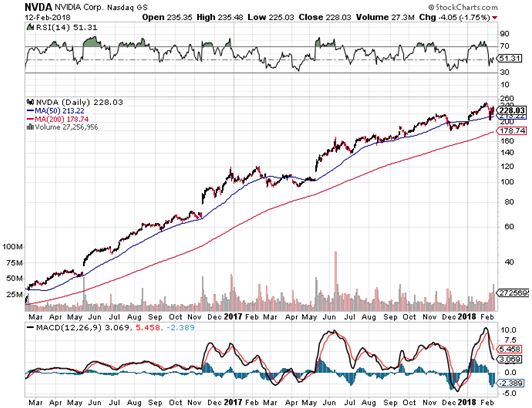

Mad Hedge Technology Letter
February 12, 2018
Fiat Lux
Featured Trade:
(DON'T FALL INTO THE SNAP TRAP),
(SNAP), (FB), (GOOGL), (AMZN)

It is often said that the best performance of a share price is triggered when the fundamentals go from awful to merely terrible.
That has certainly been the case for long suffering SNAP (SNAP), which delivered one of the best performing stocks in an otherwise disastrous market last week, up an amazing 37%.
You can thank this ballistic move due to a surprise report delivering earnings of 12 cents a share, the first ever for the company. The company added 9 million daily users, taking their total to 187 million. The number of adds place rose by 400%.
So much for the silver lining. Now for the cloud.
SNAP is a minnow attempting to swim in an ocean filled with sharks and whales, like Alphabet (GOOGL), and Amazon (AMZN).
Ad prices fell by 70%. SNAP is expected to continue to lose money through 2021. What's worse, Facebook (FB) is about to eat their lunch, appetizer, entree, and dessert in all.
SNAP was one of the preeminent IPO disasters of 2017. It launched in March at $17 and then soared 44% on the first day to $29. It then collapsed to a low of $11.40, off a heartbreaking 60.68%. It was a classic case of investment banker incompetence, greed, and mispricing.
Snapchat, wildly popular with adolescents and young adults, is a social networking platform that took off when it debuted on NYSE in March 2017.
Based on photos and videos clips the user can "snap" and send to other users, only to disappear after viewing, this innovation allowed the young people of the world access to the ultimate social media dream: a quick and convenient way of documenting every waking moment of their lives (generally through the smartphone app).
Sadly, the exuberance was short lived.
Snapchat was the most accurate description of a technology laggard in 2017.
Imitation is the sincerest form of flattery and understanding the machinations at a technical level with give us more color.
The addition of a new feature, giving users the option of adding snaps to their "story", a chronological account of their day vanishing in 24 hours, seemingly caught the attention of other big players who were taking careful tabs on this progress.
Facebook (FB) seamlessly cloned the same core features responsible for Snapchat's (or Snap Inc.) rise to fame.
Modern-day tech is made up of unique networks that are often difficult to build; once built and scaled efficiently, however, the reach cannot be replicated.
Gaining eyeballs is what feeds Snap's success. As Facebook and it's daughter companies systematically mimic its best features, user preference to stay within the familiar Facebook ecosystem, rather than venturing into the unknown, has become more evident.
Facebook's Instagram will continue to position itself accordingly as competitors in the tech space start to cannibalize each other for user attention. This is definitely not a "rising tide lifts all boats" scenario. There are winners and losers in this game, and Snap's direct rivalry with Instagram doesn't make its prospects look good.
2018 marks a key year for Facebook; protecting the core user experience will be vital for harvesting user trust in the arena. This natural evolution has forced Facebook CEO Mark Zuckerberg to prioritize personal networks over brute commerce.
We can expect a short term hit to ad load, but an offset by improved quality user experience in the long term. Spinning off new ideas, fluid integration, and brisk execution illustrates the ability of Facebook management teams to adapt and reload.
Granted, Snapchat had a late start, a factor partly responsible for their showing up to a shootout with a butter knife. All the same, the daunting Instagram challenge seems grim because the digital ad duopoly is hard to disrupt and if their DAU growth is already this unimpressive then watch out below!
Tech titans plow a substantial portion of their cash back into developing their user experience, which is critical to engaging active users, stabilizing ad pricing, and increasing ad load. In short, it's an arduous task for Snap to compete with Instagram's unlimited resources.
M&A has taken hold in the tech world, with the behemoths identifying companies that would exhibit synergies fitting into their ecosystems; cash is certainly not a problem.
Examples are rampant: Amazon's purchase of Whole Foods, Facebook's purchase of Oculus Rift, etc. In cases where Goliath doesn't buy David out, he crushes him under relentless competition.
This means that even if Snap improves its user experience, Facebook can mobilize its developers to replicate these functions almost instantaneously, throttling any hope of making a comeback by moving in a different direction.
Snapchat is in the midst of rolling out a major redesign of its platform to commercialize their product, but does it matter? Facebook will simply take the best parts of the new redesign and integrate it into Instagram as free innovation.
Nor does it help that many companies felt it unnecessary to buy ads on Snap when Facebook and Instagram have more user engagement follow through and over 2 billion active daily users.
That's the game today: have the technology to imitate competitors and trap users inside an ecosystem; hyper-improve the experience, and any and every click of the mouse benefits the bottom line through data analytics, ads, and sales.
As the tech space has matured, the juggernauts have realized that speed and agility will help them offer a better user experience, regardless of where the innovation comes from.
Inevitably, Facebook ad pricing will rise due to less inventory, and this short squeeze will drive growth in earnings. Facebook ad offerings are, in effect, an auction and the price can be bid up. Any company that cannot afford Facebook's rates can logically migrate to Instagram where the pricing is a level lower and geared to a younger audience with lower spending power.
Simple supply and demand will exacerbate competition for these ads like the San Jose housing market. At the same time, it's unsurprising that the Snap revenue estimates have been guided lower and lower and actually there is no guidance for Q1 2018 while Facebook's revenue accelerates. This is not coincidence. Don't forget that a stock is worthy of your undivided attention if it sequentially beats earnings and raises revenue consistently like Nvidia (NVDA).
Snap catastrophically fails at the two most important metrics for tech growth companies: daily active user growth and accelerated revenue growth. Q4 2017 was a transition quarter but the odds are asymmetrically stacked against them.
The torrid equity strength in the first month of the year failed to include Snap, while interest rate-sensitive stocks and large tech stocks skyrocketed. Moreover, Snap's daily active user growth has flattened like a pancake to 2.9% in Q3 2017 and Q4 showed anemic increases allowing the Mad Hedge Fund Trader to paint Snap as transitional at best.
With marginal stocks typically being victim to the steepest and swiftest declines, expect that if the market rolls over and consolidates further, Snap may likely be bludgeoned into nonexistence.
For Facebook, on the other hand, the only downside is they may need to start coming up with their own innovations.
Avoid SNAP. If you own SNAP get rid of it, and thank the heavens it spiked on earnings which gave traders a perfect exit point for Snap. After the broad market correction has run its course, Snap will not be the torchbearer of the next gap up. If you are looking for a Snap like replacement in your portfolio then Twitter (TWTR) would fit like a glove.
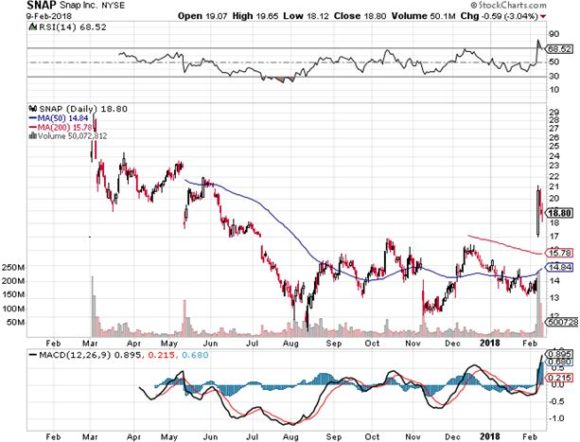

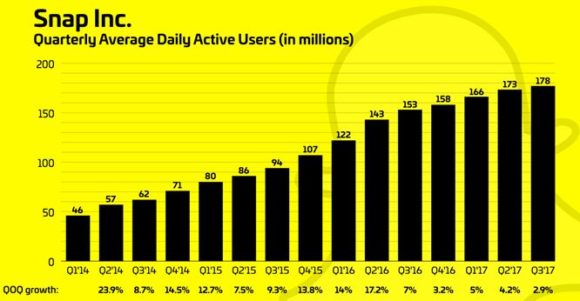
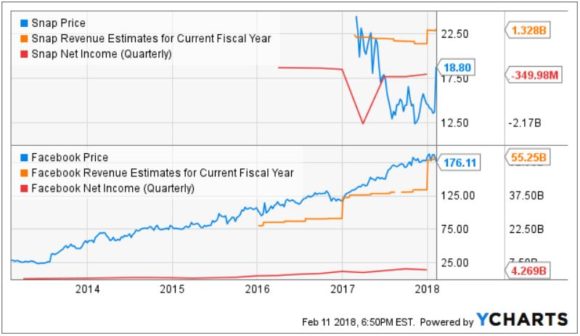
Global Market Comments
February 8, 2018
Fiat Lux
Featured Trade:
(SALESFORCE POWERS ON),
(CRM), (FB), (MSFT), (GOOGL), (AAPL)

Usually, when a company builds a new office tower that is the highest west of the Mississippi, it is a sign that business is great.
That is certainly the case with San Francisco based Salesforce, the overwhelming leader of the CRM industry.
The ever-ebullient CEO of Salesforce, Marc Benioff, sure made a splash at Davos World Economic Forum pointing the finger at Facebook (FB) and comparing it to carcinogenic like dangers.
Benioff certainly has the clout in Silicon Valley to make such bold statements. A home grown local hero, graduating from the peninsula's plebeian Burlingame High School, Marc has grown into a tech titan in his own right.
Marc is also the largest philanthropist in the San Francisco Bay Area. The UCSF hospital network has been the beneficiary of $300 million worth of munificence.
Benioff is currently offering $100,000 cash to every middle school in Northern California to buy new computers.
And here's the really amazing thing. Amazon tried to buy Salesforce for $50 billion 18 months ago, and Benioff turned them down! If Benioff had taken Amazon stock in the deal he would be worth some $120 billion today.
Salesforce usually doesn't receive the wow factor that a Facebook (FB), Alphabet (GOOGL), and Apple (AAPL) get, partially because it's less integrated into the realm of everyday consumer use.
What exactly is Salesforce? And what the heck is CRM?
Ask the average Joe and he would be befuddled and exasperated by the very question. Salesforce's own management describes itself as a "wall-to-wall software platform that manages every aspect of the customer journey from marketing to sales to service."
Marc Benioff inaugurated the software-as-a-service (SaaS) revolution in the late 1990's that has been adopted by virtually all other tech contemporaries.
Instead of paying a one-time fee like everyone used to do when they bought Microsoft Office 365, customers pay a reoccurring yearly subscription just like the services offered by the Mad Hedge Fund Trader.
I must confess that Marc beat me to this business model by a few years, but I can vouch for its effectiveness.
The revolutionary CRM (Customer Relationship Management) platform they provide does not exude glamour because it's usage is confined to highly specialized back office employees who rejoice in its easy functionality and innovative features.
For Netflix, only one metric is taken seriously for avid investors; total subscription growth.
Salesforce is another tech growth company driven by one number: Total Revenue Growth. Anytime Salesforce publish data, investors flip to the only number that matters.
All high growth tech stocks must relentlessly push the accelerating growth narrative and keep earnings growing and share prices rising, or face shunning by investors.
A tech growth company simply cannot be a growth company if they aren't over delivering on total revenue expectations.
Salesforce is definitely not pussyfooting around when it comes to their performance. Revenues pierced the $10 billion mark in FY 2017. The encore did not disappoint, stating that Total Annual Revenue should soar to $20 billion by 2022, $40 billion by 2028, and $60 billion by 2034. The growth frenzy is music to investors' ears.
You'd be hard pressed to find any Wall Street analyst not super bullish about their revenue prospects.
How is Salesforce pulling this off?
Some 57% of Salesforce customers this year are brand new. Existing customers buy more products as the working relationships evolve and the grizzled old customers cannot switch to any other platform because de-integrating their business from Salesforce would be a living nightmare.
The Mad Hedge Fund Trader can vouch for this, when we moved over our email service and payment processing to incorporate the higher volume, our team of developers were about to tear their hair out. Can you imagine a Fortune 500 company of 50,000 employees smoothly switching platforms?
Peruse the financials and you can see that Salesforce is running on high octane fuel. Late last year, Salesforce launched the financial services cloud for retail banking to enable banks to deliver highly personalized intelligent and connected banking experiences for consumers.
They also further advanced their relationships with PNC Bank and KeyBanc. ING is also expanding its operations with Salesforce globally to meet their goal of becoming a one platform bank.
Once a financial firm gains entrance into the Salesforce ecosphere, they sooner or later invest in more Salesforce SaaS services because they desire better functionality and attempt to offer a better customer experience. In fact, today some 17 of the top 20 U.S. and European banks use Salesforce as their primary platform.
Other high momentum areas include health and life sciences. Some 15 of the world's 20 largest pharmaceutical companies rely on Salesforce as its CRM provider. Anthem (ANTM), one of the largest health insurers in the United States, deepened their commitment as well.
UnitedHealth Group significantly expanded with Salesforce to help build its next generation of patient and customer engagement for more than 125 million customers. (CRM)'s vision is to make healthcare more cost effective, efficient, predictive and intelligent, using the Salesforce platform.
A huge win for Salesforce was one of the largest public-sector deals to-date with the Department of Homeland Security; this follows a large transaction with the Veterans Administration.
Domestically, a good chunk of Fortune 500 companies have made the jump into CRM, and is the first software program employees see as they turn on their computers every day.
On the international front, growth mirrors the domestic invincibility.
Overseas, Salesforce has been gradually increasing distribution capacity, expanding their partner ecosystem, investing in offices and infrastructure, and opening new data centers. All of these investments are clearly paying dividends.
Europe was the fastest growing region powered by some great strategic victories with Cellcom from Israel, which is the largest cellular operator in that country. Another is PostNord Sverige, jointly owned by the governments of Sweden and Denmark, and employs over 40,000 Swedes who are all using Salesforce products daily.
Other companies that use the Salesforces holistic platform are TNT Express, a shipping company headquartered in Liege, Belgium, French insurance company AXA based in Paris, France employing 165,000 employees.
The list goes on in Europe with Swiss's food and beverage mainstay Nestle, headquartered in Vevey, Switzerland, employing 350,000 people world wide.
The Asia and pacific region saw major inroads with Japan's Shinsei Bank, Meiji Yasuda, South Korea's Samsung, and Australia's Telstra, a telecommunications and media corporation that operates telco networks and markets voice, mobile, internet access, and pay television. Telstra is by far Australia's largest telecommunications company.
In Latin America, Salesforce expanded their alliance with the largest private bank in Brazil, Banco Itau of Sau Paulo.
Salesforce has been thriving in Japan, strengthening relationships with Hitachi, Ebara, and Mitsui Sumitomo Insurance. Asia continues to be one of the fastest growing regions, with 27% quarterly growth.
In Europe, the Middle East, and Africa, Salesforce grew 33% in constant currency terms and continued to build relationships with marquee brands including BP, British Petroleum, headquartered in London, England, and France's Group PSA, the second largest car manufacturer in Europe. It is present in 160 countries and is the manufacturer of automobiles and motorcycles sold under the Peugeot, Citroen, DS, Opel and Vauxhall brands.
Salesforce has upped their international headcount by around 30% annually since FY 2014. That is a prolific rate of growth.
You do not need to be a rocket scientist to understand that this breakneck expansion phase is warranted. Salesforce has recently nudged up FY 2018 revenue guidance estimates to $10.44 billion.
Salesforce continues to improve its product mix by swallowing up smaller niche tech companies that add a smattering of specific functions that help companies run more efficiently.
Some recent acquisitions include cloud-based Quip. Quip is productivity software and allows groups to create and edit documents and spreadsheets as a team. This firm is led by Bret Taylor, the creator of Google Maps and also the former CTO of Facebook.
Taylor has created the next generation technology of live documents, bringing a new level of content, communication and collaboration right into the Salesforce platform. And yes, these are the add-ons that Salesforce customers must pay for.
To improve Quip, Salesforce captured Attic Labs, inventors of open sourced decentralized database Noms. The technology is expected to remain open source and will be incorporated into Quip.
Attic Labs will contribute Quip with back-end support, allowing the function to pull more data onto the Quip pages. Salesforce doled out a derisory $11 million for this latest trinket.
Other AI firms bought by Salesforce will integrate into the platform, including RelateIQ, MetaMind, Implisit, PredictionIO, and Tempo AI.
The attention on AI as the next wave of the CRM industry has forced Salesforce to assemble a machine learning team of more than 175 of the best data scientists who built the amazing "Einstein" platform.
Salesforce is one of the biggest proponents of AI, and even their upper level management team has an AI manager critiquing their top-level managers at weekly meetings alongside Marc Benioff, surely a first at any firm.
Salesforce is bolstering its AI partnership with IBM. The two have been cooperating in tandem since last year and the latest announcement added to their partnership with Salesforce denominating IBM as its favored cloud service provider and IBM denominating Salesforce as its favored customer engagement platform for sales and services.
IBM's Watson AI and Salesforce's Einstein AI supplement sales leads by diagnosing the premium and inferior leads.
Artificial Intelligence (AI) is adding to their vast array of capabilities allowing Salesforce to retain and nurture customers while charging them more for better service offerings.
Salesforce remains a pillar of the tech revolution and best of breed in CRM. Each earnings report will be splattered with a smorgasbord of reputable companies that have adopted Salesforce as its go to CRM platform.
The pipeline looks luminous for Salesforce as the natural progression to enterprise cloud computing will get rid of exorbitant IT infrastructure and uneconomical maintenance costs.
As Salesforce's reinvests back into their service offerings, companies will clamor more for these sensational products. The Salesforce platform of next will appear mightily different from the past as it continues to evolve at warp speed.
Salesforce is a strong conviction "BUY". To learn more about Salesforce, please visit the company website by clicking here.
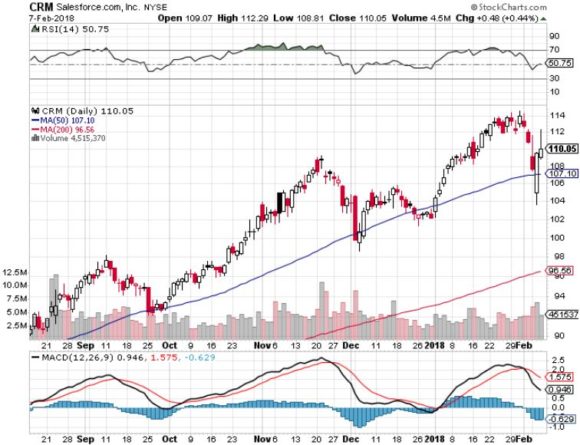
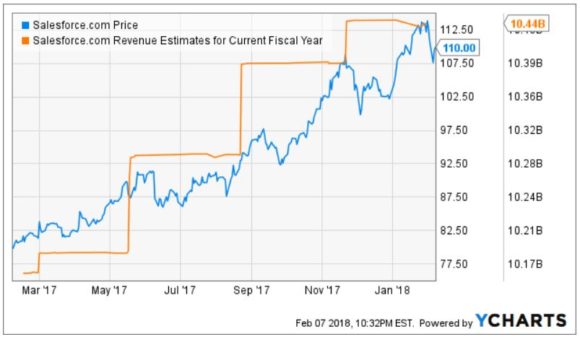
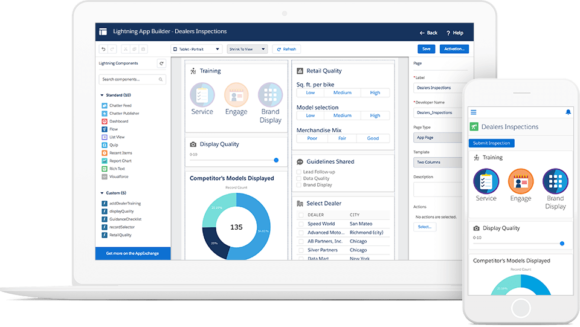

Mad Hedge Technology Letter
February 7, 2018
Fiat Lux
(SPECIAL TECH MARKET BOTTOM ISSUE),
Featured Trade:
(TEN TECH STOCKS TO BUY AT THE MARKET BOTTOM),
(AAPL), (AMZN), (GOOGL), (FB), (NVDA),
(BABA), (NFLX), (MU), (CRM), (MSFT)

When the dust settles from this sharp selloff, the bargain hunters will come out in droves. A plethora of high quality names will be available for a serious discount and the Mad Hedge Fund Trader is going to tell you exactly which tech names you should dip your toe into.
Many investors have been shut out of tech because their ascent was so rapid. Here is a chance for a second bite of the Apple.
??
Apple (AAPL)
Apple, the creators of the iPhone and IoS operating system, is hitting all the right notes despite the recent correction. Apple stock is under selling pressure due to tepid guidance.
However, iPhone unit sales are not as bad as initially thought when analyzed more closely. The underlying growth drivers are still intact, and management will explain details about how they will allocate their cash hoard in the spring.
The stock valuation is mouthwatering and just dropped from 15.7X forward PE to the current 13.74X in a matter of 10 trading days. For investors who can withstand the short-term whipsawing, the recent pullback in Apple looks like a godsend long term.
??
Amazon (AMZN)
The unrelenting land grab continues for this stock and the health industry is the latest potential victim.
This predator is blowing past any guidance put forth and analysts estimates are repeatedly blown out of the water. Carrying the load is their cloud play, Amazon Web Services, which finances its e-commerce division to full effect.
This is why they can afford operating at such low margins and offer prime subscribers free two-day shipping. Amazon's cloud unit is the rapidly expanding and most profitable business of the company.
For the quarter, AWS sales jumped 45% YOY, while generating $1.3 billion in operating income, a whopping 64% share of Amazon's total operating income.
The AWS revenue came in at??$5.11 billion vs. $4.97 billion, and Amazon's CFO Brian Olsavsky detailed record order volume and improved warehouse efficiency during the busy holiday shopping season for the recent winter.
In the last few days, some analysts have raised their price targets to $1800 and cannot keep pace with the parabolic price action.
??
Alphabet (GOOGL)
Digital advertising is a two horse race these days, with Google (GOOGL) and Facebook (FB) controlling between 60-70% of the total digital ad market share.
The total market revenue of global digital advertising and total media advertising are shaping out to be like a hockey stick. This should spur major revenue growth on just advertising alone.
Advertisers are demanding more granularity in hyper- targeting capabilities to reach specific desired consumers. Google and Facebook have smartly positioned themselves at the front of this demand curve by being the ad publishers with some of the best-of-breed targeting abilities in the digital ad space.
Facebook is able to provide targeting based upon consumer interests and Google executing based on the data provided by user searches and this twin behemoth have an insurmountable lead among digital ad publishers.
Facebook (FB)
This stock is a great buy and shares many of the same synergies with Google. Duopolies are very positive for shareholders, meaning very little digital ad revenue are not taken in by these two tech giants.
Cornering an industry is a tough objective to meet, but decades of perfecting and beefing up their ad developer technology is showing up vividly on the earnings reports.
There simply is nowhere else to go if you want to advertise on a mobile, digital platform and expose yourself to a great number of high quality customers.
Advertisers do not have any other choice except Google, which is on this list to no surprise. Facebook approximately tracks users to 80% of habitually used websites by operating tracking tools that activate if you are still logged in to the social media platform. They can literally see and jot down your every digital move.
??
Netflix (NFLX)
An Amazon-esque stock that shrugs off earnings for new subscriber growth. Who cares if they have negative cash flow if they are growing their subscribers at a insanely fast clip?
The only metric investors are interested in is total new subscriber growth, and the street had expected a not too shabby 6.39 million. Netflix easily eclipsed this total by adding 8.33 million.
Netflix has an uncannily low attrition rate due to the high premium content it offers customers creating an optimal customer experience. Netflix is really going pedal to the medal by investing over $8 billion in original content this year.
This is a stark difference from their previous business model by investing in non-original programming produced by other companies like Disney. Disney finally woke up to the erosion and swiftly purchased 21st Century Fox last year and plans to launch its own Netflix imitation shortly.
If Netflix persists to deliver fantastic content and I am confident they will then this growth story will remain intact for shareholders.
??
Alibaba (BABA)
The Chinese online sales platform is a proxy for the health of the Chinese economy and particularly the Chinese consumer.
The sales segment surged 57% higher in its core commerce division. This division accounted for 88% of Alibaba's total third-quarter revenues.
Though far smaller, the cloud computing division more than doubled its sales to $553 million. Alibaba's management plans to invest large chunks of the quarter's $7.1 billion in free cash flows into accelerating this vital business even further.
The company reached 580 million monthly active users in December, a 17% year-over-year gain. Annual active subscribers for calendar year 2017 landed at an amazing 515 million, a 16% increase from 2016's levels.
The expansion of smartphone and ubiquitous high-speed internet penetration has helped drive revenues in the core commerce business across China. They also agreed buy a 33% stake in valuable??Ant Financial Services Group, formerly known as Alipay. Ant Financial is the most valuable fintech company in the world and its 3rd party payment processor is the most popular method of payment in greater China.
The relationship started back in 2014 and unremarkably most goods bought on Taobao and T-Mall, Alibaba???s digital sales platform, are paid with Ant Financials payment technology.
In the cloud segment Alibaba leads all Chinese companies and is comparable to the Amazon???s AWS in America. Trailing distantly, but growing rapidly, was Alibaba, whose cloud??earned $553 million??in revenue in the last quarter, representing a 104% YOY jump, yet they still lag behind Amazon, Microsoft, IBM, and Google in the cloud wars.
The stock was in dire need of a healthy pull back and the selloff was exactly what the doctor ordered after Alibaba made a parabolic move in January from $172 to $205.
This is no doubt at least a $200 stock and investors will be vindicated for buying the dip.
??
Salesforce (CRM)
Salesforce provides enterprise software, delivered through the cloud and is present in many Fortune 500 companies.??
This Customer Relationship Management (CRM) platform is the modern way to amalgamate staff???s resources and give them tools to work together, even if different branch offices dot both hemispheres.
The Company focuses on cloud, mobile, tablet, Internet of Things (IoT) and artificial intelligence technologies.
The Company???s service offerings are configured and integrated with other platforms and enterprise applications and really is the best of show in this space.
Marc Benioff leads this brigade and audaciously set a mammoth target of $20 billion in revenue by FY2022. I am the last person that would bet against this.
Micron (MU)
The DRAM and NAND chip company from which companies beg to get sufficient amount of chips to power their smartphones, homepods, AI related products, IoT devices, and autonomous cars.
These products are simply pieces of junks without these (MU)???s chips. From 2017, numerous semiconductor chips CEO???s have chimed in with declaring the pricing environment as ???firm???.No surprise that Apple is charging $1000 for smartphones now, as pricey chip inputs erode more of their margins which are passed on to the consumer.
DRAM and NAND chip demand see no signs of slowing, as the exponential growth in data require more of these chips per device to be adequately functional. DRAM and NAND chip players should be the heart of any tech portfolio investors assemble.
??
Nvidia (NVDA)
The GPU (Graphics Processing Unit) is the core driver for Nvidia. The fundamental levers for this company are Artificial Intelligence (AI), self-driving cars, cryptocurrency, and eSports. All of these drivers hugely depend upon Graphic Processing Units (GPUs) and Nvidia is one of the main manufacturers of GPUs.
Every segment of their business is ascending, and their CEO, Jensen Huang, is a genius. When all these brand spanking new technologies hit the mass market, exponential growth in demand for GPU???s will be a certainty. The problem until today is finding any sort of entry point into this stock. Now you finally have one!
Microsoft (MSFT)
This is not your father???s Microsoft.
The revamped version of this company has a fresh business model based on the cloud. A few years ago (MSFT) was headed for the graveyard with its stale legacy business of Bill Gates???s era percolating around their Seattle offices.
However, what a comeback with Microsoft Azure; Microsoft???s enterprise cloud software offering a mix of solutions for companies and is the number two cloud platform behind Amazon.
Microsoft Azure is also growing faster that Amazon with 98% growth YOY, this is double Amazon???s AWS growth. They are truly a force to be reckoned with and are a legitimate option for companies looking for a hybrid medley of enterprise cloud software.
The product performance has fostered rave reviews around the business community. The demand for cloud solutions will explode in the coming years with every mom and pop shop and up looking to move their operations onto these platforms.
The recently upward price action is a direct result of the cloud segment catching up with Amazon and providing a legitimate alternative.
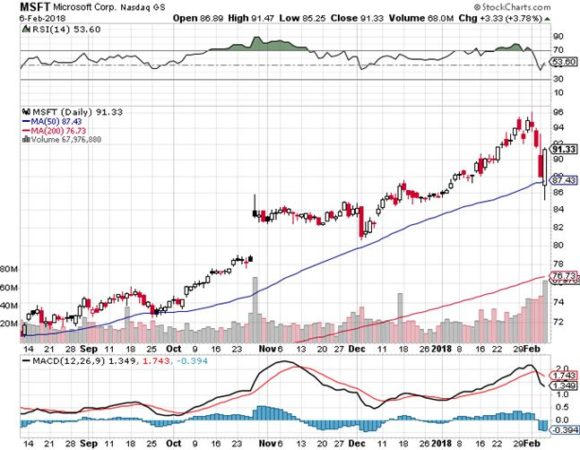
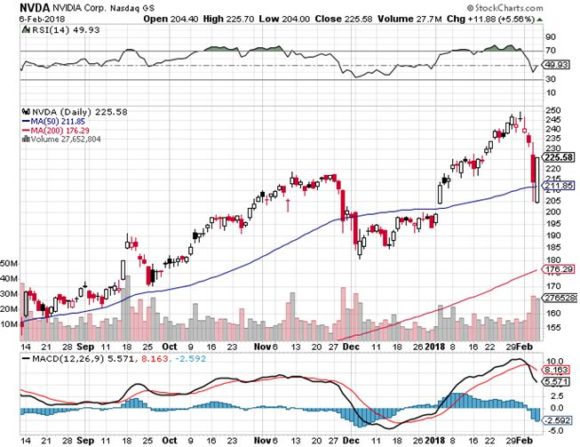
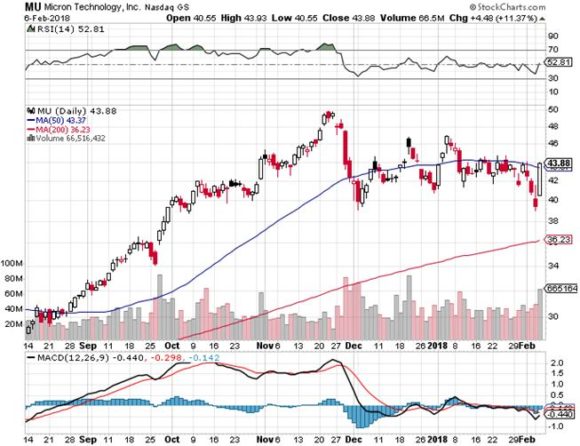
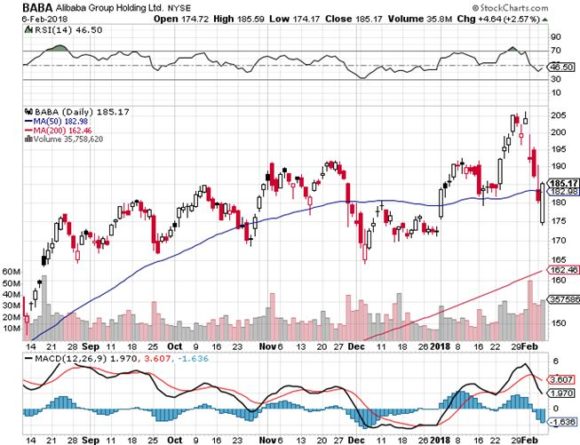

Mad Hedge Technology Letter
February 6, 2018
Fiat Lux
Featured Trade:
(A PRIMER FOR THE CLOUD),
(CRM), (ORCL), (MSFT), (GOOGL), (AMZN)

One fact came out loud and clear last week among the deluge of big technology companies last week.
You want to hitch your wagon to cloud based investments in any way, shape or form you can.
That was the writing on the wall after Amazon Web Services (AMZN) announced a blistering 45% growth in sales off of an already enormous base. Microsoft followed up with an eye-popping 98% jump is cloud services. Cloud is even starting to account for a noticeable share of Apple's (AAPL) earnings.
The future is about the cloud.
These days, the average investor probably hears about the cloud a dozen times a day. If you work in Silicon Valley you can triple that figure.
So before we get deep into the weeds with this letter on cloud services, cloud fundamentals, cloud plays, and cloud Trade Alerts, let's get into the basics of what the cloud actually is. Think of this as a cloud primer.
It's import to understand the cloud, both its strengths and limitations. Giant companies that have figured it out, like Salesforce (CRM) and Oracle (ORCL), are some of the most profitable companies in the world.
Understand the cloud and you will readily identify its bottlenecks and bulges that can lead to extreme investment opportunities. And that's where I come in.
Cloud storage refers to the online space where you can store data. It resides across multiple remote servers housed inside massive data centers all over the country, some as large as football fields, often in rural areas where land, labor, and electricity are cheap.
They are built using virtualization technology, which means that storage space spans across many different servers and multiple locations. If this sounds crazy remember that the original Department of Defense packet switching design was intended to make the system atomic bomb proof.
As a user you can access any single server at any one time anywhere in the world. These servers are owned, maintained and operated by giant third-party companies like Amazon, Microsoft, and Alphabet (GOOGL), which may or may not charge a fee for using them.
The most important features of cloud storage are:
1) It is a service provided by an external provider
2) All data is stored outside your computer and in-house network
3) A simple Internet connection will allow you to access your data at any time.
4) Because of all these features, sharing data with others is vastly easier, and you can even work with multiple people online at the same time, making it the perfect vehicle for our globalized world.
Once you start using the cloud to store a company's data, the benefits are many.
1. No Maintenance
Many companies, regardless of their size, prefer to store data inside in-house servers and data centers.
However, these require constant 24 hour a day maintenance, so the company has to employ a large in-house IT staff to manage them, a costly proposition.
Thanks to cloud storage, businesses can save tons of money on maintenance since their servers are now the headache of third-party providers.
Instead, they can focus resources on the core aspects of their business where they can add the most value, without worrying about managing IT staff of prima donnas.
2. Greater Flexibility
Today's employees want to have a better work-life balance and this goal can be best achieved through letting them telecommute. Increasingly, workers are bending their jobs to fit their lifestyles, and that is certainly the case here at Mad Hedge Fund Trader.
How else can I send off a Trade Alert while hanging from the face of a Swiss Alp?
Cloud storage services, like Google Drive, offer exactly this kind of flexibility for employees. According to a recent survey, 79% of respondents already work outside of their office some of the time, while another 60% would switch jobs if offered this flexibility.
With data stored online, it's easy for employees to log into a cloud portal, work on the data they need to, and then log off when they're done. This way a single project can be worked on by a global team, the work handed off from time zone to time zone until it's done.
It also makes them work more efficiently, saving penny pinching entrepreneurs money.
3. Better Collaboration and Communication
In today's business environment, it's common practice for employees to collaborate and communicate with co-workers located around the world.
For example, they may have to work on the same client proposal together or provide feedback on training documents. Cloud-based tools like Hightail, Dropbox, and Google Drive make collaboration and document management a piece of cake.
These products, which all offer free entry level versions, allow users to access the latest versions of any document, so they can stay on top of real time changes, which can help businesses to better manage their work flow, regardless of geographical location.
4. Data Protection
Another important reason to move to the cloud is for better protection of your data, especially in the event of a natural disaster. Hurricane Sandy wrought havoc on local data centers in New York City, forcing many websites to shut down their operations for days.
The cloud simply routs traffic around problem areas as if, yes, they have just been destroyed by a nuclear attack.
It's best to move data to the cloud, to avoid such disruptions because there your data will be stored in multiple locations.
This redundancy makes it so that, even if one area is affected, your operations don't have to suffer and data remains accessible no matter what happens. It's a system called de-duplication.
5. Lower Overhead
The cloud can save businesses a lot of money.
By outsourcing data storage to cloud providers, businesses save on capital and maintenance costs, money which in turn can be used to expand the business. Setting up an in-house data center requires tens of thousands of dollars in investment, and that's not to mention the maintenance costs it carries.
Plus, considering the security, reduced lag, up time and controlled environments that providers like Amazon's AWS have, creating an in-house data center seems about as contemporary as a buggy whip, a corset, or a Model T.
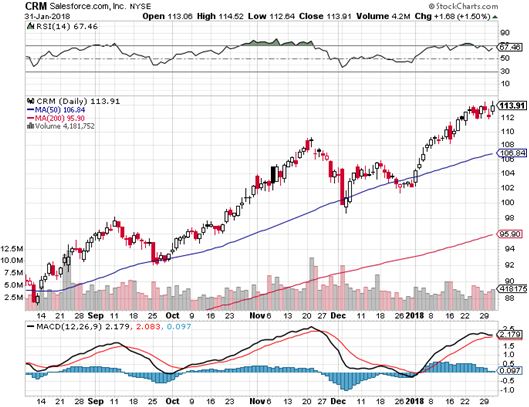
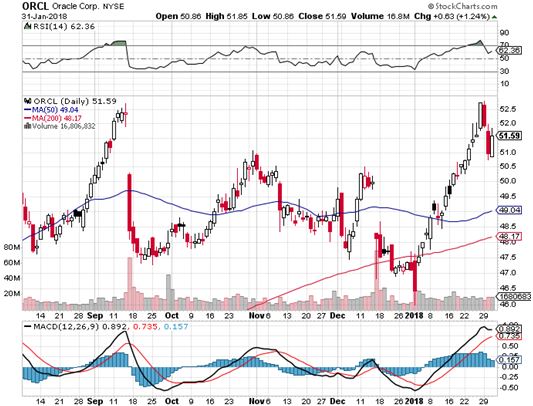
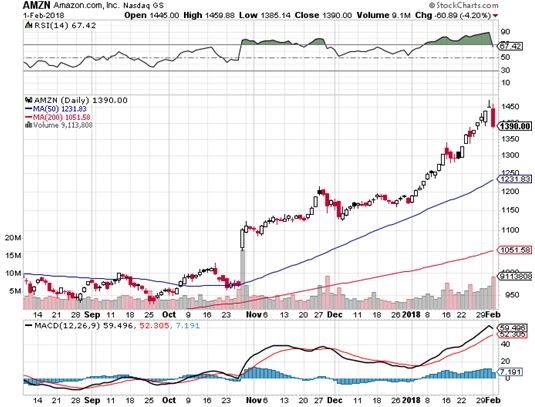

Legal Disclaimer
There is a very high degree of risk involved in trading. Past results are not indicative of future returns. MadHedgeFundTrader.com and all individuals affiliated with this site assume no responsibilities for your trading and investment results. The indicators, strategies, columns, articles and all other features are for educational purposes only and should not be construed as investment advice. Information for futures trading observations are obtained from sources believed to be reliable, but we do not warrant its completeness or accuracy, or warrant any results from the use of the information. Your use of the trading observations is entirely at your own risk and it is your sole responsibility to evaluate the accuracy, completeness and usefulness of the information. You must assess the risk of any trade with your broker and make your own independent decisions regarding any securities mentioned herein. Affiliates of MadHedgeFundTrader.com may have a position or effect transactions in the securities described herein (or options thereon) and/or otherwise employ trading strategies that may be consistent or inconsistent with the provided strategies.
This site uses cookies. By continuing to browse the site, you are agreeing to our use of cookies.
OKLearn moreWe may request cookies to be set on your device. We use cookies to let us know when you visit our websites, how you interact with us, to enrich your user experience, and to customize your relationship with our website.
Click on the different category headings to find out more. You can also change some of your preferences. Note that blocking some types of cookies may impact your experience on our websites and the services we are able to offer.
These cookies are strictly necessary to provide you with services available through our website and to use some of its features.
Because these cookies are strictly necessary to deliver the website, refuseing them will have impact how our site functions. You always can block or delete cookies by changing your browser settings and force blocking all cookies on this website. But this will always prompt you to accept/refuse cookies when revisiting our site.
We fully respect if you want to refuse cookies but to avoid asking you again and again kindly allow us to store a cookie for that. You are free to opt out any time or opt in for other cookies to get a better experience. If you refuse cookies we will remove all set cookies in our domain.
We provide you with a list of stored cookies on your computer in our domain so you can check what we stored. Due to security reasons we are not able to show or modify cookies from other domains. You can check these in your browser security settings.
These cookies collect information that is used either in aggregate form to help us understand how our website is being used or how effective our marketing campaigns are, or to help us customize our website and application for you in order to enhance your experience.
If you do not want that we track your visist to our site you can disable tracking in your browser here:
We also use different external services like Google Webfonts, Google Maps, and external Video providers. Since these providers may collect personal data like your IP address we allow you to block them here. Please be aware that this might heavily reduce the functionality and appearance of our site. Changes will take effect once you reload the page.
Google Webfont Settings:
Google Map Settings:
Vimeo and Youtube video embeds:
